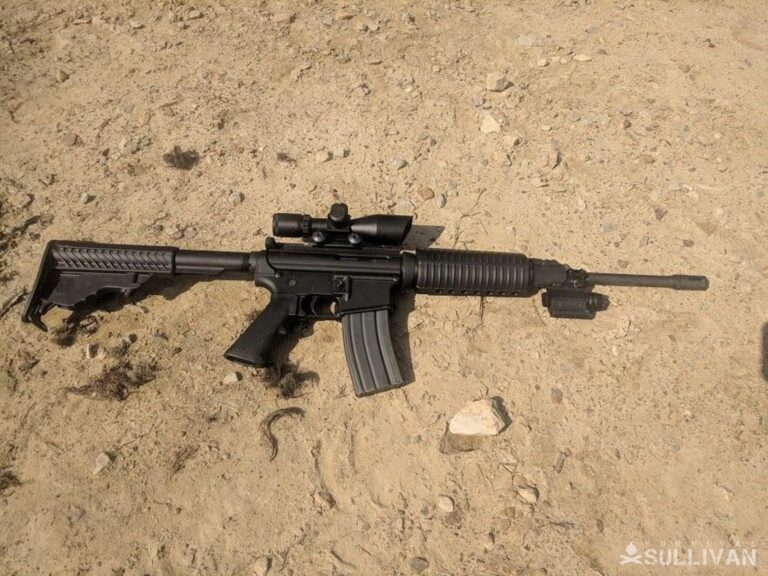Choosing a favorite between the AR-15 and the AK-47 is like choosing a favorite child. Wile Eugene Stoner and Mikhail Kalashnikov – the designers – could easily make their choice, who else can really say the same?
The design of these weapons is so different in both philosophy and practical application that such a value judgment is impossible. If you have fired either of these weapons – whether for recreation or to save the life of a fellow soldier – you understand that they are both to be admired.

I personally fired each of these about 30 years ago and was equally impressed. While my dedication to country urged me to give the edge to the AR-15, I couldn’t escape the feeling of firing the AK-47.
Call it propaganda perhaps, but I was trained to see the AK-47 as an inferior weapon. However, after years of reflection, I can’t say that I feel the same way.
While it has been decades since I fired the two in such close succession, I still feel that there is no way to declare one superior to the other. All you can do is get a better understanding of each weapon and determine your own preference. Or, like me, simply marvel equally at them both.
History
The history of these weapons are as different as their design. The AK-47 harkens back to World War II and the lessons the Soviet Union learned in their fight against Germany.
It was designed to suit the needs of an army built with drafted personnel, so it needed to be easy to train on and operate for someone with no previous experience with guns.
Mikhail Kalashnikov was a young designer who got to work on this rifle while recovering from wounds sustained as a tank driver in 1941. By 1942, he was assigned to the Chief Directorate of Artillery where his design was tested and refined.
With the fate of the existence of his nation in the balance, he was highly motivated to design a weapon that would ensure its survival.
The AR-15 was designed as a response the United States need for a new, modern rifle to compete with the AK-47 in the Southeast Asian conflicts of the 1960s. Like the AK-47, it was designed for the needs conscript but with a sophisticated vision more suited for the modern professional soldier.
In 1945, Eugene Stoner was an aviation engineer and didn’t start designing small arms until the 1950’s. While working for Armalite in 1954, he helped to design the AR-5, which was adopted by the US Air Force as a survival weapon for aircraft personnel. Between 1956 and 1958, Stoner led the design team that developed the AR-15, but the weapon wasn’t adopted until the 1960’s.
The original design was not nearly as good as the AK-47, although it was an improvement on the previously used M14. Twenty years of battlefield experience have resulted in changes that resulted in the modern AR-15, one of the greatest firearms ever designed.
Advantages of the AK-47
The AK-47 is a very simple design when compared to other rifles. One of the primary goals of Mikhail Kalashnikov was to design a weapon that was in design and practicality. A soldier can learn to use it with a minimum of practice – perfect for a newly conscripted soldier or local belligerents merely trying to protect their homeland.
The sight radius is easily adjustable from 100 to 800 meters. For maintenance and cleaning purpose, the AK-47 has six main components. The design also includes materials that are easily accessible to machine shops all over the world.
The simple design makes the AK-47 a rugged and reliable weapon. It is constructed mainly of steel, wood, and polymer. It also has very few moving parts. This rifle has proven its reliability in multiple battlefield scenarios and in almost every environment in the world.
Disadvantages of the AK-47
The biggest weakness with the AK-47 is its lack of accuracy relative to other rifles including the AR-15. But it has been proven accurate enough in most modern combat situations.
It is sufficiently accurate at short range as needed in most modern combat scenarios, and its ability to fire rapidly and its reliability are more important in short-range assault and defense situations.
Another weakness when compared to the AR-15 is its non-modular design. Different variants have to be available to achieve the flexibility of the AR-15. Noting this disadvantage, Russia has been working to improve the modularity of the weapon.
Advantages of the AR-15
The Armalite AR-15 is a gas-operated, air-cooled, magazine fed assault rifle. With a rotating bolt and a straight-line recoil, it was designed as a lightweight rifle.
The ammo was also designed to be lightweight, making it possible for soldiers to carry more ammunition into battle. It is well known for it’s easy of accuracy for a reasonably well-trained soldier.
There are several reasons for this high accuracy. Most notable are the minimal recoil, large sight radius, and lightweight polymer design. At only 8 lbs., the AR-15 is an easy to handle weapon.
The weapon can be easily altered to suit a soldier’s specific needs. This is a result of decades of wartime experience. The rifle’s four main components – stock, barrel, upper receiver, and lower receiver – can be mixed and matched, tailoring it to fit the needs of a specific soldier or a specific mission. There are thousands of options available.
Disadvantages of the AR-15
The AR-15 is a more complex weapon that the AK-47. Only a small number of manufacturers are able to make some of the milled aluminum and titanium parts. It has more components and moving parts and operated under tighter tolerances than the AK-47. An example is the bolt and carrier design.
The AK has only two parts – the bolt and bolt carrier. The AR-15 has eight parts – bolt, bolt carrier, carrier key, bolt gas rings, extractor, cam pin, firing pin, retaining pin. This greater complexity leads to more opportunities for failure.
If the rifle has a serious weakness it would be the intended round. The standard NATO 5.56 x 45mm rifle round is designed to be used with multiple firearms and not specifically for the AR-15. Some American soldiers have complained that the round lacks stopping power, leading to a Congressional inquiry.
Comparison of Firing Round
How effective a rifle is cannot be separated from the effectiveness of its round. Many arguments regarding the difference between firearms are more related to the rounds used than the weapon itself. The AK-47 fires a 7.62 x 39mm round, while the AR-15 fires the lighter weight 5.56 x 45mm round.
AT .0079 kg, the AK round has twice the mass of the AR round (.0039). While moving at a lower velocity, it produces more kinetic energy and a significant wound profile.
The increased mass and lower velocity make the round more susceptible to bullet drop and crosswind. This accounts for the disparity in accuracy between the two rifles.
The AR round is small. But, its muzzle velocity is significant, resulting in an acceptably high kinetic energy.
With a smaller mass and high velocity, accuracy is greatly improved against bullet drop and crosswind. The bullet was designed to cause maximum soft tissue damage and a significant enough wound to seriously injure or kill.
Design Philosophies
When comparing the weapons, you have to account for the fact that their design philosophy is very different.
The AK was designed as a shoulder-fired, gas-operated rifle for a conscript soldier. It is simple design makes it easy for conscripts or insurgents to learn how to use and maintain. It was made to be used over long periods of time, and extensively, with little to no maintenance required and in every possible environmental or weather condition.
After decades of improvements, the AR became the weapon of choice for highly trained professional soldiers. Modifications over the years were based on experience and in response to complaints from American soldiers. Because of the more complicated design, it took time for the AR to reach maturity and a level of performance comparable to the AK.
Why the Argument Anyway?
It is impossible to compare these two weapons with the narrow set of criteria most people give. Both fail and excel as they were meant to do, and just as they were designed. The AK-47 was designed to be reliable, rugged, and simple, with a deadly range of 300 yards.
It was also made to deliver a high volume of fire to help conscripted soldiers hit their intended targets. In each of these areas, the AK-47 excels and is undoubtedly one of the best weapons ever designed.
The AR-15 was specifically designed for accuracy at the expense of simplicity. As the weapon developed, conscript armies gave way to highly trained professional soldiers, obviating the need for a more sophisticated instrument of enemy destruction.
It too was designed to deliver a high volume of fire, but it also included the adaptability and flexibility that the modern United States soldier demands.
Steel Sharpens Steel
Both weapons have improved their design over time, largely in response to each other. The many AR-15 variants have tried to replicate the strengths of the AK-47. And like a rival prize fighter, the AK responded with improvements and modifications of its own to emulate the AR-15. By pushing each other, both weapons have been improved and adapted.
In some ways, you could say that the rifles competition had changed them so much that they resemble each other now in many ways. Both are now vastly better and very different from their original designs.
The popularity of both weapons with sportsmen, hunters, ranchers, and gun enthusiasts has also advanced their development. What makes each weapon a popular choice of soldiers also makes them a popular choice among recreational shooters.
As more military veterans return home from combat, their experiences in the field have been shared with civilians and the design community alike. Hunters of small game are particularly fond of the AR rifles. Although not powerful enough for large game hunting, they are well-suited for wild pigs, coyotes, and other dangerous and aggressive animals.
Final Verdict
The final verdict is that there is none. Not really. Both the AK-47 and the AR-15 are outstanding examples of firearm design and functionality. Choosing which is better is not realistic.
What matters is the matching the weapon to its intended application in case of WROL in a TSHTF situation. And, as they continue to grow more similar, they are become more difficult to tell apart.


My name is Teresa Fikes. I am a Homesteader, survivalist, prepper, historian, and writer plus much more all in one package deal. I was raised on a small family farm were I was taught at an early age to survive off the land without the help of modern conveniences. I am a writer by profession and a Homesteader by Blood, Sweat, and Tears.
